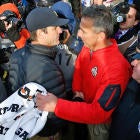There are dates when college football narratives get rewritten. Urban Meyer rewrote the script twice for the sport's two highest-profile conferences.
The first came for the SEC on Jan. 8, 2007, when Florida bludgeoned Ohio State to start a run of seven straight national championships by four different SEC programs. Then came Jan. 1, 2015, for the Big Ten. After years of serving as a punching bag in many high-profile games, the Big Ten could finally think big again.
No. 18 Wisconsin edged No. 19 Auburn at the Outback Bowl. No. 8 Michigan State rallied past No. 5 Baylor at the Cotton Bowl. Most important, Meyer and No. 4 Ohio State took down No. 1 Alabama in SEC country at the Sugar Bowl during the College Football Playoff semifinals.
"Maybe the Big Ten isn't that bad," Meyer said that night. "Maybe the Big Ten is pretty damn good, or certainly getting better. The mind is a fragile thing. ... There's no doubt that when we saw Wisconsin beat Auburn, that was a major, major moment for us to win this game."
Look at the Big Ten now. With three weeks left, four of the top eight teams in the latest CFP Rankings are from the Big Ten, which has completely flipped scripts with the SEC.
It's the Big Ten with multiple ways to make the playoff. It's not the SEC, which for the third straight year needs No. 1 Alabama's dominance to be relevant in the playoff race.
It's the Big Ten (and the ACC) with possible ways to put two teams in the playoff. It's not the SEC, which, when the CFP was created, brokered a compromise with the Big Ten so the four best teams would get picked and not the four best conference champions.
It's the Big Ten with the most accomplished group of coaches in the country. It's not the SEC, which outside of Nick Saban is rebuilding with the league's least-experienced group of coaches in 52 years.
College football is nothing if not cyclical. What's old becomes new again. Fan bases who mock eventually get mocked. It's not unlike politics. Your political party/favorite team will one day be on the outside looking in so be careful with your power while you're on top.
The SEC was never going to keep winning national titles every single year with multiple teams, though it may still be champion again with Alabama. But it's the Big Ten now displaying SEC-like depth. It's almost unprecedented depth for the Big Ten, which nearly missed the first playoff just two years ago.
"Obviously, we've had a good year and we've won some big games," Big Ten commissioner Jim Delany said. "But the reality is some teams have three games left. Most have two games left. That's a lot of football. So we're not counting any chickens. So far it's good. A couple years ago, it didn't look good and Ohio State played their way in, and I think there are teams that are really outside the mainstream that really could play their way in. We have to let it play out. No predictions, no promises."
The Big Ten enjoys several chances to place one, or even two, teams in the playoff. There's even the very real possibility No. 2 Ohio State could make the playoff without winning its division -- a concept Delany fought against after LSU and Alabama met in the 2011-12 BCS Championship Game in a rematch of SEC West opponents.
"I don't have a lot of regard for that team [Alabama]," Delany told the Associated Press in May 2012 as commissioners floated ideas for the four-team playoff. "I certainly wouldn't have as much regard for that team as I would for someone who played nine conference games in a tough conference and played a couple out-of-conference games on the road against really good opponents. If a poll doesn't honor those teams and they're conference champions, I do."
How does Delany square those remarks with Ohio State today? Delany said it's up to the CFP Selection Committee to decide and he won't say now or later if he thinks the Buckeyes deserve to go as a non-Big Ten champion.
"The debate was the four best teams without regard to anything else, or the four best champions," Delany said. "Really, we ended up with a compromise -- the four best teams but taking into consideration things like strength of schedule and conference championships won. The only way anybody goes as a non-champion or an independent is really if they do awfully well. We'll see. There's a lot of football left to be played."
The Big Ten has four teams in the top 10 of the AP Top 25 at this stage of the season for the first time since 1958. The SEC's second-highest-ranked team is No. 15 Auburn, marking the first time since 2004 the SEC has only one top-10 team with three weeks left in the season. The SEC has the fewest top-15 teams at the moment among Power Five conferences.
At this point of each season from 2006-14, the SEC had a combined 29 top-10 teams while the Big Ten had 10. Over the past two years, the top-10 scoreboard, when there's three weeks left, reads Big Ten 7, SEC 3.
There's a snowball effect to conference depth. This is the first year the Big Ten has played nine conference games. Given the Big Ten's success outside the conference, the results inside the league carry more meaning.
Wisconsin athletic director Barry Alvarez expressed some concerns about the Badgers' difficult Big Ten schedule. But the reality is that schedule helped position the No. 7 Badgers to possibly make the playoff as a two-loss Big Ten champion.
"We wanted to play each other more, but it has an ancillary benefit of creating games that people like to follow," Delany said. "We're on our way to playing no FCS [opponents]. I think we played the fewest of anyone this year."
Hiring better coaches
So what changed for the Big Ten? The coaches. This was always the Big Ten's biggest problem, even more than its very real recruiting concerns based on population shifts from the Midwest to the South.
"We should be good," Delany said. "I think the leadership the coaches have provided is probably the biggest difference. I don't think you can be really good without great leaders in those roles. But no matter how great the leadership is, you need players. It's a combination of things. For sure, we're on a nice trajectory."
Not long ago, some Big Ten coaches openly discussed a "gentleman's agreement" among themselves to not recruit players committed elsewhere. As noble as that may be, the SEC laughed. The SEC and modern college football is all about flipping commitments.
On National Signing Day in 2008, Purdue coach Joe Tiller blasted Michigan coach Rich Rodriguez for poaching wide receiver Roy Roundtree from the Boilermakers' class. "If we had an early signing date, you wouldn't have another outfit with a guy in a wizard hat selling snake oil get a guy at the last minute, but that's what happened," Tiller said at the time. (That early signing period may finally be coming, though both Saban and Meyer oppose it. Stay tuned.)
Ohio State coach Jim Tressel was asked in 2008 if a gentleman's agreement existed in the Big Ten to leave other schools' recruits alone. "I guess only among gentlemen," answered Tressel, who said his philosophy was to stop recruiting a player once he said he's going elsewhere.
Meyer changed everything for the Big Ten with his relentless recruiting tactics. After Meyer's first signing class in 2012, Michigan State and Wisconsin openly complained about his tactics when they each lost a committed player to Ohio State.
Michigan State coach Mark Dantonio told the Detroit News, "They've got a new coach, and it's different. I would say it's pretty unethical, in the end."
Wisconsin coach Bret Bielema complained of Meyer's "illegal" tactics to Sporting News. "I can tell you this. We at the Big Ten don't want to be like the SEC -- in any way, shape or form," he said. (Oh, the irony -- Bielema soon left for the SEC to coach at Arkansas.)
Meyer set the new bar. Fellow Big Ten coaches could either keep up or risk getting left behind.
"He upped the recruiting up a notch, challenged everybody a little bit," Ohio State athletic director Gene Smith said. "Look at what James Franklin does. He's been known as a great recruiter. I think he affected that at Penn State. Pat Fitzgerald has 10-win seasons and is highly competitive [at Northwestern]. We all know what [Michigan's Jim] Harbaugh can do."
Franklin and Penn State athletic director Sandy Barbour have said other schools have used the past Jerry Sandusky scandal to negatively recruit against Penn State. Franklin didn't specifically identify the schools. But at Big Ten media days last summer, some of Franklin's past remarks got interpreted into meaning Ohio State, Michigan, Michigan State and Notre Dame negatively recruit against Penn State, causing Meyer and Dantonio to strongly deny that's the case.
It was all so SEC.
Did the Big Ten need more aggressive recruiters? "I don't know about that," Delany said. "You need people who are confident, competent, have the ability to get the job done. I don't know that anybody was a more aggressive recruiter than Ron Zook [at Florida and Illinois]. Jim Tressel had a lot of great players. There's been some great players at Michigan. There's been some great offensive linemen at Wisconsin and Iowa. I think it's a competitive environment and you have to be able to compete."
Paying for coaches
The Big Ten also began shelling out more for coaches. Consider 2011, when the BCS staged the All-SEC national championship and one year before Meyer arrived at Ohio State. In 2011, the SEC had eight of the 14 highest-paid coaches in the country, according to the USA Today annual salary database.
The Big Ten? It had just four of the top 33: Iowa's Kirk Ferentz (No. 5), Michigan's Brady Hoke (No. 8), Nebraska's Bo Pelini (No. 13) and Dantonio (No. 32). Penn State's Joe Paterno made less money than three coaches in Conference USA, two in the Mountain West and one in the WAC.
In 2016, the SEC is still spending like crazy (nine of the 18 wealthiest coaches) but it's in a coaching transition. Meanwhile, the Big Ten has five of the 14 highest paid, including No. 1 Harbaugh ($9 million) and No. 3 Meyer ($6.1 million). Franklin at Penn State is now tied at No. 10, and the closest C-USA coach trails him by $3.6 million.
Since 2012, the SEC has hired coaches such as Gus Malzahn (Auburn), Jim McElwain (Florida), Kirby Smart (Georgia), Hugh Freeze (Ole Miss), Will Muschamp (South Carolina), Butch Jones (Tennessee), Kevin Sumlin (Texas A&M) and Bielema. Some have had success; some it's too soon to say but the clock is ticking because it's the SEC. None of them are Meyer or Harbaugh. There aren't many great coaches to go around and the Big Ten nabbed two of them.
Consider the pedigrees of some coaches the Big Ten has hired since 2012:
- Urban Meyer, Ohio State: Two national titles at Florida, undefeated season at Utah.
- James Franklin, Penn State: Two nine-win seasons and three bowl trips in three years at perpetually woeful Vanderbilt.
- Mike Riley, Nebraska: Ex-NFL head coach who went 93-80 at Oregon State, which is one of the hardest jobs in the Power Five.
- Paul Chryst, Wisconsin: Broyles Awad finalist as nation's top assistant while Wisconsin's offensive coordinator on back-to-back Rose Bowl teams, 19-19 record in three years at Pitt.
- Lovie Smith, Illinois: Longtime NFL coach who reached the Super Bowl with the Chicago Bears but no college coaching experience in 20 years.
- Jim Harbaugh, Michigan: Rebuilt Stanford from scratch into an Orange Bowl champion, reached the Super Bowl with the San Francisco 49ers.
These days in the Big Ten, it's Harbaugh who's the new flavor pushing the envelope with recruiting. Harbaugh shows his face anywhere and everywhere, whether it's the coaching box at spring training baseball games or wearing his glove at the World Series in October.
Harbaugh dropped some committed recruits late that caused a public firestorm. He staged a $334,711 month-long satellite camp tour (up from $211,948 for his eight-day tour in 2015) around the country that bothered some SEC and ACC coaches. He took his team to Florida over spring break for practice at IMG Academy, which is loaded with recruits, at a cost of $348,553.
In the aftermath of the Florida trip, Smith said he wouldn't support taking spring break away from Ohio State players but that "if we were jump-starting our program, I'd probably try and do that, too." Harbaugh took offense on Twitter: "Good to see Director Smith being relevant again after the tattoo fiasco," referring to Ohio State's past NCAA violations under Tressel. Smith apologized.
This, too, felt so SEC.
"Whether you'd implement [Harbaugh's] techniques, which are outstanding, or you just say that's not my style, it doesn't matter," Smith said. "You've got to up your game. I just think highly competitive people are driven harder by highly competitive people."
Consider where the Big Ten resided on Sept. 7, 2014. On that day, Ohio State lost at home to unranked Virginia Tech, Michigan got demolished by Notre Dame for the Wolverines' first shutout loss in 30 years and Michigan State fell by 19 points to Oregon. The Big Ten seemed headed for another lost season outside the national championship race.
"We're not feeling very good, but the facts are the facts," Delany told ESPN that day. "I would just say with 50 percent of the nonconference games and 100 percent of conference games remaining, it's premature to make any judgments. It's Sept. 7, not Dec. 7. I would hate to think after two weeks we'd pick any teams for anything."
That day left the Big Ten with an 8-29 record against ranked Power Five opponents over a five-year period. Since then, the Big Ten is 14-7 against ranked Power Five teams.
With three weeks left in the 2016 regular season, Delany is publicly taking a cautious approach to the Big Ten's success.
"My view is I've been in a lot of games and competitions that looked like the sun wasn't shining and seen a lot of them come out OK," Delany said. "I don't write everyday so I don't have to put a headline down or a lead. I can respond to headline or lead, but I don't write it. When you lose a few games and still have 10 to play, it's too early. Here, if you're 10 games in, it's too early to reach the conclusion, it really is. That's sort of how I try to manage my affairs."
Delany seems to understand the cardinal rule of being on top. Eventually, the script changes again and there's nowhere to go but down.





















